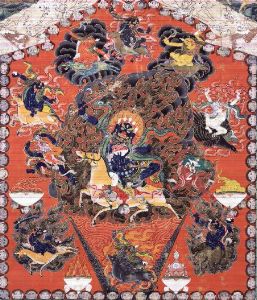
Buddhist Protector: Shri Devi, Magzor Gyalmo (Introduction)
Shri Devi Resource Page | Magzor Gyalmo Outline Magzor Gyalmo, meaning the Queen who Repels Armies, or the Queen who has the power to turn back armies, belongs to the larger class of enlightened protector deities known as Shri Devi, or Palden Lhamo in Tibetan. Magzor Gyalmo is a wrathful emanation of the peaceful goddess Sarasvati, popular in both Hinduism and Buddhism.
Magzor Gyalmo, meaning the Queen who Repels Armies, or the Queen who has the power to turn back armies, belongs to the larger class of enlightened protector deities known as Shri Devi, or Palden Lhamo in Tibetan. Magzor Gyalmo is a wrathful emanation of the peaceful goddess Sarasvati, popular in both Hinduism and Buddhism.
Video: Shri Devi, Introduction
Shri Devi is understood as a class of female protectors. Some say that there are twenty-one forms of Shri Devi, often including the Bon protector Sipai Gyalmo as one of the forms. Not all forms of Shri Devi have the same entity. The principal form of the protector, Dudsolma or Dudmo Remati, appearing with one face and four arms, riding a donkey, is a wrathful manifestation of Shri Lakshmi. Magzor Gyalmo with two arms, riding a mule, is a manifestation of Sarasvati. In the Bon Religion Sipai Gyalmo is the wrathful form of Satrig Ersang, one of the four principal deities/gods of the Bon Religion.
Magzor Gyalmo, often shortened to Magzorma, was first popularized in Tibet by the Zhang, Mu and Sakya family lineages. This form of Shri Devi was likely indigenous to Tibet and the result of a pure vision (dag nang) or a revealed treasure (terma) discovery. It later entered the Gelug School through the family tradition of either the 1st or the 2nd Dalai Lama (see possibly the earliest Gelug painting of Magzor Gyalmo). Again at the time of the 5th Dalai Lama in the 17th century it became the special protector of the Dalai Lama incarnation tradition and of the Ganden Podrang Government of Tibet.
The majority of Magzor Gyalmo paintings and sculpture on the HAR website were created for Gelug practitioners and institutions in Tibet, Mongolia and China. Of the nearly 100 Magzorma objects on the site only four paintings can be identified as belonging to the Sakya Tradition. All of the others are Gelug in origin. How do we know?
There are two ways to distinguish between Sakya and Gelug forms of Magzor Gyalmo. With paintings, inspecting the over-all composition, the minor figures surrounding the central Magzor Gyalmo must be looked at carefully. [1] It is most often the case that Lama Tsongkapa, founder of the Gelug Tradition, wearing a yellow hat, will be placed at the top center, and if not there then somewhere else along the top of the painting. [2] In the texts describing the iconography of Magzorma, for the Gelug, she has a snow lion as an earring for the right ear and a coiled snake for the left earring. In the Sakya Tradition this iconographic detail is reversed. Don't believe us? Look for yourself: Gelug Example, Sakya Example.
Because Magzorma is the wrathful form of Sarasvati and because Sarasvati is the goddess of learning and eloquence, then it follows that she is related to and paired with the bodhisattva of wisdom - Manjushri. However, it would not be proper to have the peaceful appearance of Manjushri associated with the wrathful appearance of Magzorma. So, with all of that said, Magzorma is most commonly associated with the wrathful forms of Manjushri: Heruka Vajrabhairava, Rakta Yamari or Krishna Yamari. These three are the most wrathful forms of Manjushri. They are also meditational deities of the Anuttarayoga Classification of Tantra. It is very common to find one of these three wrathful figures of Manjushri at the top of a Magzorma painting. Sakya paintings generally portray Rakta Yamari at the top along with one or two Lama figures; often Ngorchen Kunga Zangpo, wearing a red pandita hat.
In the Tantra narrating the history of Magzorma she is described as the servant or younger sister of Shri Devi (with four arms). Aside from functioning as a protector deity in the Sakya and Gelug Traditions of Tibetan Buddhism, Magzor Gyalmo is used extensively in the ritual of divination - generally using dice or prayer beads.
Description of Magzor Gyalmo: "... Shri Devi Remati, Queen of the Army Repelling Weapons, riding a mule, blue-black in colour, with one face and two hands, having bared fangs and gnashing down on a human corpse. Possessing three round red eyes, and the forehead furrowed into a frown, brown hair flowing upwards with licks of flame and smoke issuing forth. The right ear is adorned with a poisonous snake and the left with a lion, crowned with five dry human skulls and a necklace of fifty blood dripping wet [heads] strung with intestines. ... having a lower garment of tiger skin, a snake belt and necklace, etc. The right hand holds to the sky a sandalwood stick marked with a vajra. The left holds to the heart a mustard seed and blood filled skullcup. ... At the level of the navel is a sun and at the crown of the head a crescent moon; above the head is a peacock parasol canopy." (Sharchen Champa Kunga Tashi 1558-1603, TBRC P778. Drub Tab Kun Tu vol.9, pp.606-607. TBRC W19221).
The textual source for Magzor Gyalmo is the Dakinyagnijihajvala Tantra, Dege Kanjur, volume 98, pp.223-253. It is found in the Nyingma Tantra section, vol.3.
Jeff Watt [updated 8-2017]